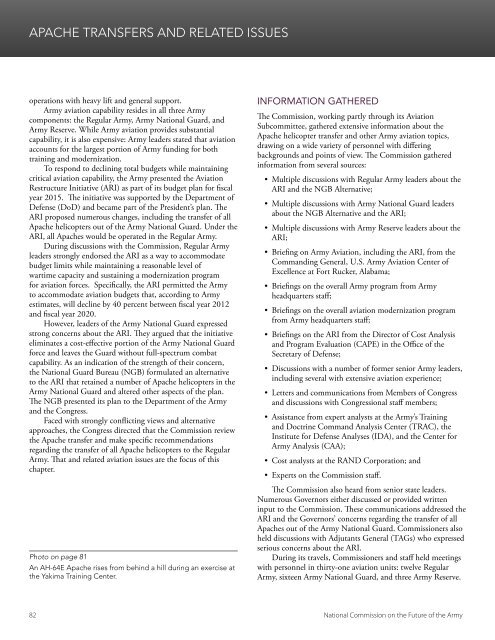THE FUTURE OF THE ARMY
Futurearmy
Futurearmy
You also want an ePaper? Increase the reach of your titles
YUMPU automatically turns print PDFs into web optimized ePapers that Google loves.
APACHE TRANSFERS AND RELATED ISSUES<br />
operations with heavy lift and general support.<br />
Army aviation capability resides in all three Army<br />
components: the Regular Army, Army National Guard, and<br />
Army Reserve. While Army aviation provides substantial<br />
capability, it is also expensive: Army leaders stated that aviation<br />
accounts for the largest portion of Army funding for both<br />
training and modernization.<br />
To respond to declining total budgets while maintaining<br />
critical aviation capability, the Army presented the Aviation<br />
Restructure Initiative (ARI) as part of its budget plan for fiscal<br />
year 2015. The initiative was supported by the Department of<br />
Defense (DoD) and became part of the President’s plan. The<br />
ARI proposed numerous changes, including the transfer of all<br />
Apache helicopters out of the Army National Guard. Under the<br />
ARI, all Apaches would be operated in the Regular Army.<br />
During discussions with the Commission, Regular Army<br />
leaders strongly endorsed the ARI as a way to accommodate<br />
budget limits while maintaining a reasonable level of<br />
wartime capacity and sustaining a modernization program<br />
for aviation forces. Specifically, the ARI permitted the Army<br />
to accommodate aviation budgets that, according to Army<br />
estimates, will decline by 40 percent between fiscal year 2012<br />
and fiscal year 2020.<br />
However, leaders of the Army National Guard expressed<br />
strong concerns about the ARI. They argued that the initiative<br />
eliminates a cost-effective portion of the Army National Guard<br />
force and leaves the Guard without full-spectrum combat<br />
capability. As an indication of the strength of their concern,<br />
the National Guard Bureau (NGB) formulated an alternative<br />
to the ARI that retained a number of Apache helicopters in the<br />
Army National Guard and altered other aspects of the plan.<br />
The NGB presented its plan to the Department of the Army<br />
and the Congress.<br />
Faced with strongly conflicting views and alternative<br />
approaches, the Congress directed that the Commission review<br />
the Apache transfer and make specific recommendations<br />
regarding the transfer of all Apache helicopters to the Regular<br />
Army. That and related aviation issues are the focus of this<br />
chapter.<br />
Photo on page 81<br />
An AH-64E Apache rises from behind a hill during an exercise at<br />
the Yakima Training Center.<br />
INFORMATION GA<strong>THE</strong>RED<br />
The Commission, working partly through its Aviation<br />
Subcommittee, gathered extensive information about the<br />
Apache helicopter transfer and other Army aviation topics,<br />
drawing on a wide variety of personnel with differing<br />
backgrounds and points of view. The Commission gathered<br />
information from several sources:<br />
• Multiple discussions with Regular Army leaders about the<br />
ARI and the NGB Alternative;<br />
• Multiple discussions with Army National Guard leaders<br />
about the NGB Alternative and the ARI;<br />
• Multiple discussions with Army Reserve leaders about the<br />
ARI;<br />
• Briefing on Army Aviation, including the ARI, from the<br />
Commanding General, U.S. Army Aviation Center of<br />
Excellence at Fort Rucker, Alabama;<br />
• Briefings on the overall Army program from Army<br />
headquarters staff;<br />
• Briefings on the overall aviation modernization program<br />
from Army headquarters staff;<br />
• Briefings on the ARI from the Director of Cost Analysis<br />
and Program Evaluation (CAPE) in the Office of the<br />
Secretary of Defense;<br />
• Discussions with a number of former senior Army leaders,<br />
including several with extensive aviation experience;<br />
• Letters and communications from Members of Congress<br />
and discussions with Congressional staff members;<br />
• Assistance from expert analysts at the Army’s Training<br />
and Doctrine Command Analysis Center (TRAC), the<br />
Institute for Defense Analyses (IDA), and the Center for<br />
Army Analysis (CAA);<br />
• Cost analysts at the RAND Corporation; and<br />
• Experts on the Commission staff.<br />
The Commission also heard from senior state leaders.<br />
Numerous Governors either discussed or provided written<br />
input to the Commission. These communications addressed the<br />
ARI and the Governors’ concerns regarding the transfer of all<br />
Apaches out of the Army National Guard. Commissioners also<br />
held discussions with Adjutants General (TAGs) who expressed<br />
serious concerns about the ARI.<br />
During its travels, Commissioners and staff held meetings<br />
with personnel in thirty-one aviation units: twelve Regular<br />
Army, sixteen Army National Guard, and three Army Reserve.<br />
82 National Commission on the Future of the Army


